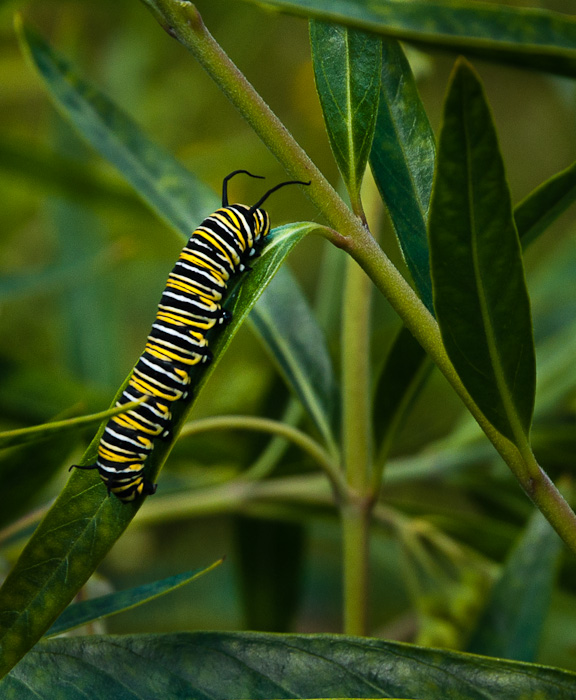Almost hidden - white, yellow and black stripes - I had begun to wonder if I would see any this season...

A Monarch butterfly (Danaus plexippus) caterpillar surrounded by its food, the leaves of a swan plant. Swan plants belong to the milkweed family, so called because of the milky sap, and they are often planted here specifically to provide for the very fussy Monarch caterpillars. They feed almost exclusively on milkweed plants in order to get cardenolides, a type of cardiac glycoside, which they accumulate in their bodies. Apparently this is required for successful pupation and transformation into the beautiful butterflies. It is also a toxic substance - these plants are not for human consumption!
In the small beastie world dramatic and eye-catching appearance often signals a kind of "eat me if you dare" message and generally means that being noxious to eat is their survival strategy. Unfortunately for the Monarch cat (as enthusisasts call them), accumulating a toxic substance in your body doesn't stop some wasps, soldier bugs and the odd praying mantis from eating you.
Monarch butterflies are self-introduced to New Zealand - they appear to have island-hopped on the way and were first recorded here in 1873. Their feats of flight are amazing. And their severe decline in their native North America and Mexico is alarming. So - having inspected a few swan plants and failed to see any sign of Monarch caterpillars this summer, it was a real treat for me to catch a glimpse of this one and a few siblings, all looking quite plump and close to pupating.
Milkweed or the Asclepiadoideae is a large family of plants with only a handful available in NZ. It is the host plant for the Monarch butterfly, which lays its eggs on the plant, and then the caterpillars begin to eat the leaves.
It is named for its milky juice, which contains alkaloids, latex, and several other complex compounds including cardenolides. Some species are known to be toxic. However, do not get the plant family confused with plants such as dandelion, sow thistles, portulaca and Euphorbia species etc. – all of which also have a milky sap.
- See more at: http://www.monarch.org.nz/monarch/species/monarchs/monarch-host-plants/milkweed/#sthash.198sgwKl.dpuf